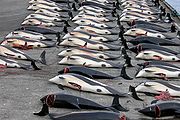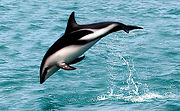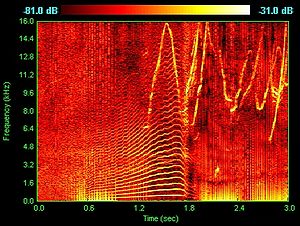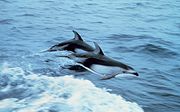
Dolphin
Background Information
The articles in this Schools selection have been arranged by curriculum topic thanks to SOS Children volunteers. See http://www.soschildren.org/sponsor-a-child to find out about child sponsorship.

Dolphins are marine mammals that are closely related to whales and porpoises. There are almost forty species of dolphin in seventeen genera. They vary in size from 1.2 m (4 ft) and 40 kg (90 lb) ( Maui's dolphin), up to 9.5 m (30 ft) and 10 tonnes (9.8 long tons; 11 short tons) (the orca or killer whale). They are found worldwide, mostly in the shallower seas of the continental shelves, and are carnivores, mostly eating fish and squid. The family Delphinidae is the largest in the Cetacean order, and evolved relatively recently, about ten million years ago, during the Miocene. Dolphins are among the most intelligent animals, and their often friendly appearance and seemingly playful attitude have made them popular in human culture.
Etymology
The name is originally from Greek δελφίς (delphís), "dolphin", which was related to the Greek δελφύς (delphus), "womb". The animal's name can therefore be interpreted as meaning "a 'fish' with a womb". The name was transmitted via the Latin delphinus (the romanization of the later Greek δελφῖνος - delphinos), which in Middle Latin became dolfinus and in Old French daulphin, which reintroduced the ph into the word. The term mereswine has also historically been used.
The word is used in a few different ways. It can mean:
- any member of the family Delphinidae (oceanic dolphins),
- any member of the families Delphinidae and Platanistoidea (oceanic and river dolphins),
- any member of the suborder Odontoceti (toothed whales; these include the above families and some others),
- and is used casually as a synonym for bottlenose dolphin, the most common and familiar species of dolphin.
This article uses the second definition and does not describe porpoises (suborder Odontoceti, family Phocoenidae). Orcas and some closely related species belong to the Delphinidae family and therefore qualify as dolphins, even though they are called whales in common language. A group of dolphins is called a "school" or a "pod". Male dolphins are called "bulls", females "cows" and young dolphins are called "calves".
Taxonomy

- Suborder Odontoceti, toothed whales
- Family Delphinidae, oceanic dolphins
- Genus Delphinus
- Long-Beaked Common Dolphin, Delphinus capensis
- Short-Beaked Common Dolphin, Delphinus delphis
- Genus Tursiops
- Common Bottlenose Dolphin, Tursiops truncatus
- Indo-Pacific Bottlenose Dolphin, Tursiops aduncus
- Genus Lissodelphis
- Northern Rightwhale Dolphin, Lissodelphis borealis
- Southern Rightwhale Dolphin, Lissodelphis peronii
- Genus Sotalia
- Tucuxi, Sotalia fluviatilis
- Costero, Sotalia guianensis
- Genus Sousa
- Indo-Pacific Hump-backed Dolphin, Sousa chinensis
- Chinese White Dolphin (the Chinese variant), Sousa chinensis chinensis
- Atlantic Humpbacked Dolphin, Sousa teuszii
- Indo-Pacific Hump-backed Dolphin, Sousa chinensis
- Genus Stenella
- Atlantic Spotted Dolphin, Stenella frontalis
- Clymene Dolphin, Stenella clymene
- Pantropical Spotted Dolphin, Stenella attenuata
- Spinner Dolphin, Stenella longirostris
- Striped Dolphin, Stenella coeruleoalba
- Genus Steno
- Rough-Toothed Dolphin, Steno bredanensis
- Genus Cephalorhynchus
- Chilean Dolphin, Cephalorhynchus eutropia
- Commerson's Dolphin, Cephalorhynchus commersonii
- Heaviside's Dolphin, Cephalorhynchus heavisidii
- Hector's Dolphin, Cephalorhynchus hectori
- Genus Grampus
- Risso's Dolphin, Grampus griseus
- Genus Lagenodelphis
- Fraser's Dolphin, Lagenodelphis hosei
- Genus Lagenorhynchus
- Atlantic White-Sided Dolphin, Lagenorhynchus acutus
- Dusky Dolphin, Lagenorhynchus obscurus
- Hourglass Dolphin, Lagenorhynchus cruciger
- Pacific White-Sided Dolphin, Lagenorhynchus obliquidens
- Peale's Dolphin, Lagenorhynchus australis
- White-Beaked Dolphin, Lagenorhynchus albirostris
- Genus Orcaella
- Australian Snubfin Dolphin, Orcaella heinsohni
- Irrawaddy Dolphin, Orcaella brevirostris
- Genus Peponocephala
- Melon-headed Whale, Peponocephala electra
- Genus Orcinus
- Killer Whale (Orca), Orcinus orca
- Genus Feresa
- Pygmy Killer Whale, Feresa attenuata
- Genus Pseudorca
- False Killer Whale, Pseudorca crassidens
- Genus Globicephala
- Long-finned Pilot Whale, Globicephala melas
- Short-finned Pilot Whale, Globicephala macrorhynchus
- Genus † Australodelphis
- † Australodelphis mirus
- Genus Delphinus
- Family Platanistidae
- Ganges and Indus River Dolphin, Platanista gangetica with two subspecies
- Ganges River Dolphin (or Susu), Platanista gangetica gangetica
- Indus River Dolphin (or Bhulan), Platanista gangetica minor
- Ganges and Indus River Dolphin, Platanista gangetica with two subspecies
- Family Iniidae
- Amazon River Dolphin (or Boto), Inia geoffrensis
- Family Lipotidae
- Baiji (or Chinese River Dolphin), Lipotes vexillifer (possibly extinct, since December 2006)
- Family Pontoporiidae
- La Plata Dolphin (or Franciscana), Pontoporia blainvillei
- Family Delphinidae, oceanic dolphins
Six species in the family Delphinidae are commonly called "whales", but genetically are dolphins. They are sometimes called blackfish.
- Melon-headed Whale, Peponocephala electra
- Killer Whale (Orca), Orcinus orca
- Pygmy Killer Whale, Feresa attenuata
- False Killer Whale, Pseudorca crassidens
- Long-finned Pilot Whale, Globicephala melas
- Short-finned Pilot Whale, Globicephala macrorhynchus
Hybridization
In 1933, three strange dolphins beached off the Irish coast; they appeared to be hybrids between Risso's and bottlenose dolphins. This mating was later repeated in captivity, producing a hybrid calf. In captivity, a bottlenose and a rough-toothed dolphin produced hybrid offspring. A common-bottlenose hybrid lives at SeaWorld California. Other dolphin hybrids live in captivity around the world or have been reported in the wild, such as a bottlenose- Atlantic spotted hybrid. The best known hybrid is the wolphin, a false killer whale-bottlenose dolphin hybrid. The wolphin is a fertile hybrid. Two wolphins currently live at the Sea Life Park in Hawaii; the first was born in 1985 from a male false killer whale and a female bottlenose. Wolphins have also been observed in the wild.
Evolution and anatomy
Evolution
Dolphins, along with whales and porpoises, are descendants of terrestrial mammals, most likely of the Artiodactyl order. The ancestors of the modern day dolphins entered the water roughly fifty million years ago, in the Eocene epoch.
Modern dolphin skeletons have two small, rod-shaped pelvic bones thought to be vestigial hind limbs. In October 2006, an unusual bottlenose dolphin was captured in Japan; it had small fins on each side of its genital slit, which scientists believe to be a more pronounced development of these vestigial hind limbs.
Anatomy
Dolphins have a streamlined fusiform body, adapted for fast swimming. The tail fin, called the fluke, is used for propulsion, while the pectoral fins together with the entire tail section provide directional control. The dorsal fin, in those species that have one, provides stability while swimming.
Though it varies by species, basic coloration patterns are shades of grey, usually with a lighter underside, often with lines and patches of different hue and contrast.
The head contains the melon, a round organ used for echolocation. In many species, elongated jaws form a distinct beak; species such as the bottlenose have a curved mouth which looks like a fixed smile. Some species have up to 250 teeth. Dolphins breathe through a blowhole on top of their head. The trachea is anterior to the brain. The dolphin brain is large and highly complex, and is different in structure from that of most land mammals.
Unlike most mammals, dolphins do not have hair, except for a few hairs around the tip of their rostrum which they lose shortly before or after birth. The only exception to this is the Boto river dolphin, which has persistent small hairs on the rostrum.
Dolphins' reproductive organs are located on the underside of the body. Males have two slits, one concealing the penis and one further behind for the anus. The female has one genital slit. A mammary slit is positioned on either side of the female's genital slit.
A recent study at the U.S. National Marine Mammal Foundation revealed dolphins are the only animals other than humans that develop a natural form of type 2 diabetes, which may lead to a better understanding of the disease and new treatments for both humans and dolphins.
Senses
Most dolphins have acute eyesight, both in and out of the water, and they can hear frequencies ten times or more above the upper limit of adult human hearing. Though they have a small ear opening on each side of their head, it is believed hearing underwater is also, if not exclusively, done with the lower jaw, which conducts sound to the middle ear via a fat-filled cavity in the lower jaw bone. Hearing is also used for echolocation, which all dolphins have. Dolphin teeth are believed to function as antennae to receive incoming sound and to pinpoint the exact location of an object. The dolphin's sense of touch is also well-developed, with free nerve endings densely packed in the skin, especially around the snout, pectoral fins and genital area. However, dolphins lack an olfactory nerve and lobes, and thus are believed to have no sense of smell. They do have a sense of taste and show preferences for certain kinds of fish. Since dolphins spend most of their time below the surface, tasting the water could function like smelling, in that substances in the water can signal the presence of objects that are not in the dolphin’s mouth.
Though most dolphins do not have hair, they do have hair follicles that may perform some sensory function. The small hairs on the rostrum of the Boto river dolphin are believed to function as a tactile sense possibly to compensate for the Boto's poor eyesight.
Behaviour

Dolphins are often regarded as one of Earth's most intelligent animals, though it is hard to say just how intelligent. Comparing species' relative intelligence is complicated by differences in sensory apparatus, response modes, and nature of cognition. Furthermore, the difficulty and expense of experimental work with large aquatic animals has so far prevented some tests and limited sample size and rigor in others. Compared to many other species, however, dolphin behaviour has been studied extensively, both in captivity and in the wild. See cetacean intelligence for more details.
Social behaviour

Dolphins are social, living in pods of up to a dozen individuals. In places with a high abundance of food, pods can merge temporarily, forming a superpod; such groupings may exceed 1,000 dolphins. Individuals communicate using a variety of clicks, whistles and other vocalizations. They make ultrasonic sounds for echolocation. Membership in pods is not rigid; interchange is common. However, dolphins can establish strong social bonds; they will stay with injured or ill individuals, even helping them to breathe by bringing them to the surface if needed. This altruism does not appear to be limited to their own species however. The dolphin Moko in New Zealand has been observed guiding a female Pygmy Sperm Whale together with her calf out of shallow water where they had stranded several times. They have also been seen protecting swimmers from sharks by swimming circles around the swimmers or charging the sharks to make them go away.
Dolphins also display culture, something long believed to be unique to humans (and possibly other primate species). In May 2005, a discovery in Australia found Indo-Pacific bottlenose dolphins (Tursiops aduncus) teaching their young to use tools. They cover their snouts with sponges to protect them while foraging. This knowledge is mostly transferred by mothers to daughters, unlike simian primates, where knowledge is generally passed on to both sexes. Using sponges as mouth protection is a learned behavior. Another learned behaviour was discovered among river dolphins in Brazil, where some male dolphins use weeds and sticks as part of a sexual display.
Dolphins engage in acts of aggression towards each other. The older a male dolphin is, the more likely his body is to be covered with bite scars. Male dolphins engage in such acts of aggression apparently for the same reasons as humans: disputes between companions and competition for females. Acts of aggression can become so intense that targeted dolphins sometimes go into exile as a result of losing a fight.
Male bottlenose dolphins have been known to engage in infanticide. Dolphins have also been known to kill porpoises for reasons which are not fully understood, as porpoises generally do not share the same diet as dolphins, and are therefore not competitors for food supplies.
Reproduction and sexuality
Dolphin copulation happens belly to belly; though many species engage in lengthy foreplay, the actual act is usually brief, but may be repeated several times within a short timespan. The gestation period varies with species; for the small Tucuxi dolphin, this period is around 11 to 12 months, while for the orca, the gestation period is around 17 months. They usually become sexually active at a young age, even before reaching sexual maturity. The age of sexual maturity varies by species and gender.
Dolphins are known to have sex for reasons other than reproduction, sometimes also engaging in homosexual behavior. Various species sometimes engage in sexual behavior including copulation with other dolphin species. Sexual encounters may be violent, with male dolphins sometimes showing aggressive behaviour towards both females and other males. Occasionally, dolphins behave sexually towards other animals, including humans.
Feeding
Various methods of feeding exist among and within species, some apparently exclusive to a single population. Fish and squid are the main food, but the false killer whale and the orca also feed on other marine mammals.
One common feeding method is herding, where a pod squeezes a school of fish into a small volume, known as a bait ball. Individual members then take turns plowing through the ball, feeding on the stunned fish. Coralling is a method where dolphins chase fish into shallow water to more easily catch them. In South Carolina, the Atlantic bottlenose dolphin takes this further with "strand feeding", driving prey onto mud banks for easy access. In some places, orcas come to the beach to capture sea lions. Some species also whack fish with their flukes, stunning them and sometimes knocking them out of the water.
Reports of cooperative human-dolphin fishing date back to the ancient Roman author and natural philosopher Pliny the Elder. A modern human-dolphin partnership currently operates in Laguna, Santa Catarina, Brazil. Here, dolphins drive fish towards fishermen waiting along the shore and signal the men to cast their nets. The dolphins’ reward is the fish that escape the nets.
Vocalizations
 |
Recording of dolphins whistling, whining, and clicking.
|
| Problems listening to this file? See media help. | |
Dolphins are capable of making a broad range of sounds using nasal airsacs located just below the blowhole. Roughly three categories of sounds can be identified: frequency modulated whistles, burst-pulsed sounds and clicks. Dolphins communicate with their whistles and burst-pulsed sounds, though the nature and extent of that ability is not known. At least some dolphin species can identify themselves using a signature whistle. The clicks are directional and are for echolocation, often occurring in a short series called a click train. The click rate increases when approaching an object of interest. Dolphin echolocation clicks are amongst the loudest sounds made by marine animals.
Jumping and playing
Dolphins occasionally leap above the water surface, and sometimes perform acrobatic figures (e.g. the spinner dolphin). Scientists are not certain about the purpose(s) of the acrobatics. Possibilities include locating schools of fish by looking at above-water signs like feeding birds, communicating with other dolphins, dislodging parasites or simple amusement.
Play is an important part of dolphin culture. Dolphins play with seaweed and play-fight with other dolphins. At times they harass other local creatures, like seabirds and turtles. Dolphins enjoy riding waves and frequently surf coastal swells and the bow waves of boats, at times “leaping” between the dual bow waves of a moving catamaran. Occasionally, they playfully interact with swimmers. Captive dolphins have been observed in aquariums engaging in complex play behaviour which involves the creation and manipulation of bubble rings.
Sleeping
Generally, dolphins sleep with only one brain hemisphere in slow-wave sleep at a time, thus maintaining enough consciousness to breathe and to watch for possible predators and other threats. Earlier sleep stages can occur simultaneously in both hemispheres. In captivity, dolphins seemingly enter a fully asleep state where both eyes are closed and there is no response to mild external stimuli. Respiration is automatic; a tail kick reflex keeps the blowhole above the water if necessary. Anesthetized dolphins initially show a tail kick reflex. Though a similar state has been observed with wild Sperm Whales, it is not known if dolphins in the wild reach this state. The Indus river dolphin has a different sleep method from other dolphin species. Living in water with strong currents and potentially dangerous floating debris, it must swim continuously to avoid injury. As a result, this species sleeps in very short bursts which last between 4 and 60 seconds.
Threats
Natural threats
Except for humans (discussed below), dolphins have few natural enemies. Some species or specific populations have none, making them apex predators. For most of the smaller species of dolphins, only a few of the larger sharks, such as the bull shark, dusky shark, tiger shark and great white shark are a potential risk, especially for calves. Some of the larger dolphinic species, especially orcas (killer whales), may also prey smaller dolphins, but this seems rare. Dolphins also suffer from a wide variety of diseases and parasites.
Human threats

Some dolphin species face an uncertain future, especially some river dolphin species such as the Amazon river dolphin, and the Ganges and Yangtze river dolphin, which are critically or seriously endangered. A 2006 survey found no individuals of the Yangtze river dolphin, which now appears to be functionally extinct.
Pesticides, heavy metals, plastics, and other industrial and agricultural pollutants that do not disintegrate rapidly in the environment concentrate in predators such as dolphins. Injuries or deaths due to collisions with boats, especially their propellers, are also common.
Various fishing methods, most notably purse seine fishing for tuna and the use of drift and gill nets, unintentionally kill many dolphins. Accidental by-catch in gill nets and incidental captures in antipredator nets that protect marine fish farms are common and pose a risk for mainly local dolphin populations. In some parts of the world, such as Taiji in Japan and the Faroe Islands, dolphins are traditionally considered as food, and are killed in harpoon or drive hunts. Dolphin meat is high in mercury, and may thus pose a health danger to humans when consumed.
Dolphin safe labels attempt to reassure consumers fish and other marine products have been caught in a dolphin-friendly way. The original deal with "Dolphin safe" labels was brokered in the 1980s between marine activists and the major tuna companies, and involved decreasing incidental dolphin kills by up to 50% by changing the type of nets being used to catch the tuna. It should be noted that the dolphins are only netted while fishermen are in pursuit of smaller tuna. Albacore are not netted this way, which makes albacore the only truly dolphin-safe tuna.
Loud underwater noises, such as those resulting from naval sonar use, live firing exercises, or certain offshore construction projects, such as wind farms, may be harmful to dolphins, increasing stress, damaging hearing, and causing decompression sickness by forcing them to surface too quickly to escape the noise.
Relationships with humans
Mythology
Dolphins have long played a role in human culture. Dolphins are common in Greek mythology and there are many coins from ancient Greece which feature a man or boy or deity riding on the back of a dolphin. The Ancient Greeks welcomed dolphins; spotting dolphins riding in a ship’s wake was considered a good omen. In Hindu mythology, the Ganges River Dolphin is associated with Ganga, the deity of the Ganges river.
Popular culture
In more recent times, the 1963 Flipper movie and the subsequent 1964 television series, popularized dolphins in Western society. The series, created by Ivan Tors, portrayed a dolphin as a kind of seagoing Lassie. Flipper was a Bottlenose Dolphin who understood commands and always behaved heroically. Flipper was remade in 1996. In the 1990s science fiction television series seaQuest DSV featured a bottle-nose named Darwin who could communicate using a vocoder, a fictional invention which translated clicks and whistles to English and back. The 1993 movie Free Willy made a star of the Orca playing Willy, Keiko. The 1977 horror movie Orca paints a less friendly picture of the species. Here, a male Orca takes revenge on fishermen after the killing of his mate. The 1973 movie The Day of the Dolphin portrayed kidnapped dolphins performing a naval military assassination using explosives. This was also explored in the similarly named Simpsons Treehouse of Horror episode, Night of the Dolphin, where Lisa frees a dolphin at a aquarium attraction and unwittingly initiates their plan to overthrow the land-dwellers and live in their place. In The Hitchhiker's Guide to the Galaxy series, dolphins are the second most intelligent species on Earth (after mice).
Dolphinaria
The renewed popularity of dolphins in the 1960s resulted in the appearance of many dolphinaria around the world, making dolphins accessible to the public. Criticism and animal welfare laws forced many to close, although hundreds still exist around the world. In the United States, the best known are the SeaWorld marine mammal parks. Since the late 1960s, SeaWorld’s Shamu orca shows have become popular. In 1988, SeaWorld had Southwest Airlines paint three aircraft in "Shamu" colors to promote their parks.
Welfare
Organizations such as the Mote Marine Laboratory rescue and rehabilitate sick, wounded, stranded or orphaned dolphins, while others, such as the Whale and Dolphin Conservation Society and Hong Kong Dolphin Conservation Society, work on dolphin conservation and welfare. India has declared the Dolphin as their national aquatic animal in an attempt to protect the endangered Ganges River Dolphin. The Vikramshila Gangetic Dolphin Sanctuary has been created in the Ganges river for the protection of the animals.
Various scientists to have researched Dolphin behaviour have proposed that their unusually high intelligence compared to other animals means that dolphins should be seen as non-human persons that should have their own specific rights, and that it is morally unacceptable to keep them captive for entertainment purposes, or to kill them; either intentionally for consumption or as by-catch.
Therapy
Dolphins are an increasingly popular choice of animal-assisted therapy for psychological problems and developmental disabilities. For example, a 2005 study found dolphins an effective treatment for mild to moderate depression. However, this study was criticized on several grounds. For example, it is not known whether dolphins are more effective than common pets. Reviews of this and other published dolphin-assisted therapy (DAT) studies have found important methodological flaws and have concluded that there is no compelling scientific evidence that DAT is a legitimate therapy or that it affords more than fleeting mood improvement.
Military
A number of militaries have employed dolphins for various purposes from finding mines to rescuing lost or trapped humans. The military use of dolphins, however, drew scrutiny during the Vietnam War when rumors circulated that the United States Navy was training dolphins to kill Vietnamese divers. The United States Navy denies that at any point dolphins were trained for combat. Dolphins are still being trained by the United States Navy on other tasks as part of the U.S. Navy Marine Mammal Program. The Russian military is believed to have closed its marine mammal program in the early 1990s. In 2000 the press reported that dolphins trained to kill by the Soviet Navy had been sold to Iran.
Literature
Dolphins are also common in contemporary literature, especially science fiction novels. Dolphins play a military role in William Gibson's short story Johnny Mnemonic, in which cyborg dolphins find submarines and decode encrypted information. Dolphins play a role as sentient patrollers of the sea enhanced with a deeper empathy toward humans in Anne McCaffrey's The Dragonriders of Pern series. In the Known Space universe of author Larry Niven, dolphins play a significant role as fully recognised "legal entities". More humorous is Douglas Adams’ The Hitchhiker's Guide to the Galaxy series of picaresque novels, in which dolphins are the second most intelligent creatures on Earth (after mice, followed by humans) and try in vain to warn humans of Earth’s impending destruction. Their story is told in So Long, and Thanks for All the Fish. Much more serious is their major role in David Brin's Uplift series. A talking Dolphin named "Howard" helps Hagbard Celine and his submarine crew fight the evil Illuminati in Robert Shea and Robert Anton Wilson's Illuminatus Trilogy.
Dolphins appear frequently in non-science fiction literature. In the book The Music of Dolphins by author Karen Hesse, dolphins raise a girl from the age of four until the coast guard eventually discovers her. Fantasy author Ken Grimwood wrote dolphins into his 1995 novel Into the Deep about a marine biologist struggling to crack the code of dolphin intelligence, including chapters written from a dolphinian viewpoint.
Art
Dolphins are a popular artistic motif, dating back to ancient times. Examples include the Triton Fountain by Bernini and depictions of dolphins in the ruined Minoan palace at Knossos and on Minoan pottery.
Cuisine
Dolphin meat is consumed in a small number of countries world-wide, which include Japan and Peru (where it is referred to as chancho marino, or "sea pork"). While Japan may be the best-known and most controversial example, only a very small minority of the population has ever sampled it.
Dolphin meat is dense and such a dark shade of red that it almost appears black. Fat is located in a layer of blubber between the meat and the skin. When dolphin meat is eaten in Japan, it is often cut into thin strips and eaten raw as sashimi, garnished with onion and either horseradish or grated garlic, much as with sashimi of whale or horse meat (basashi). When cooked, dolphin meat is cut into bite-size cubes and then batter-fried or simmered in a miso sauce with vegetables. Cooked dolphin meat has a flavor very similar to beef liver.














